- 1Department of Physics, College of Science, Yanbian University, Yanji, China
- 2State Key Laboratory of Surface Physics and Department of Physics, Fudan University, Shanghai, China
We investigate a non-Hermitian modified Haldane model on a honeycomb lattice incorporating third nearest neighbor hopping
1 Introduction
Since the discovery of the quantum Hall effect and topological insulators [1–7], substantial research has concentrated on the topological properties of the two-dimensional honeycomb lattice. A series of novel topological phases beyond the classical Landau phase transition theory have been discovered, making the exploration of novel topological phases and phase transitions [8–19] a rapidly emerging hotspot in the field of condensed matter physics. The Haldane model [20], a seminal contribution to the field of topological materials, offers a theoretical framework for understanding the band structure, topological invariants, and edge states associated with a honeycomb lattice. This model describes a honeycomb lattice with nearest-neighbor (N1) and next-nearest-neighbor (N2) hoppings terms, along with staggered on-site energy that breaks inversion symmetry. Moreover, the Haldane model exemplifies a distinctive system in which quantum Hall effect [20, 21] is inherently linked to the properties of the lattice band structure through the introduction of a magnetic phase
Over the past few decades, research on topological phases and topological phase transitions in two-dimensional materials has primarily been based on the assumption of Hermitian Hamiltonians. However, real physical systems are typically open and interact with the environment, making it inevitable to search for novel topological phases in non-Hermitian systems. In recent years, significant advances have been achieved in investigating topological phases and properties associated with the Haldane model in non-Hermitian systems incorporating gain and loss mechanisms [22–26]. Unlike their Hermitian counterparts, non-Hermitian systems not only provide accurate simulations of the open system behaviors in practical environments [27, 28], but they also exhibit unique features, including complex-valued energy spectra [29–31], nonorthogonal eigenvectors [32], parity-time
Inspired by the aforementioned inquiries, we explore the topological properties of the non-Hermitian modified Haldane model, which incorporates the third nearest neighbor (N3) hopping
2 Model and Hamiltonian
We consider a non-Hermitian Haldane model on the honeycomb lattice, as illustrated in Figure 1. This model features distinct complex on-site mass terms, with the real parts
where
where
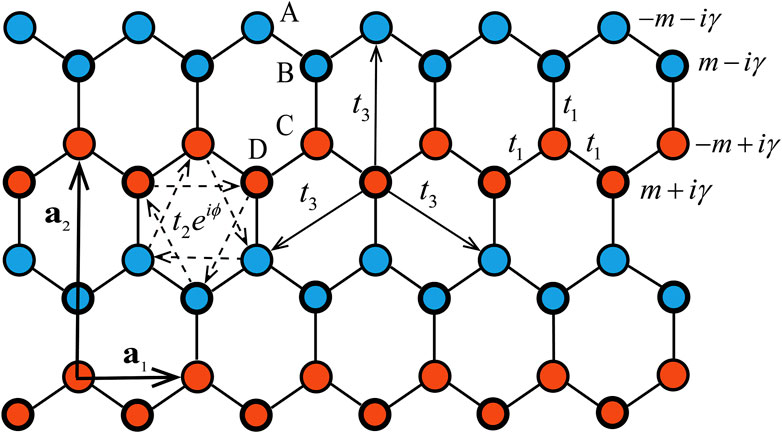
Figure 1. Schematic of a modified non-Hermitian Haldane lattice with complex on-site mass terms, where the real parts
3 Results and discussion
3.1 Pseudo-Hermitian and anti-
We turn to discuss the symmetries of the current system with
where
We introduce a complete set of biorthonormal eigenvectors
where
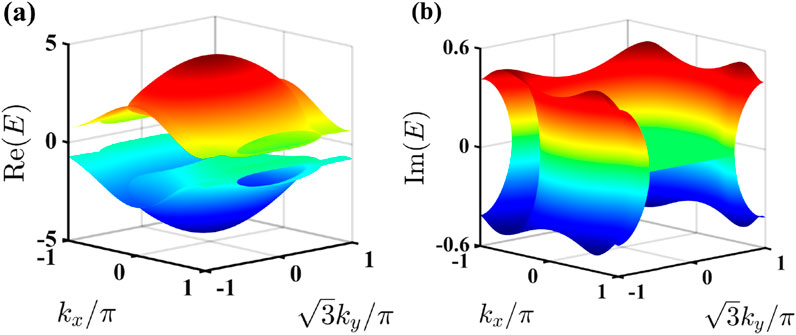
Figure 2. (a) Real and (b) imaginary parts of the energy spectrum of modified non-Hermitian Haldane model in momentum space. The parameters of the system are set to
3.2 Chern numbers and phase diagram
To compute the Berry phase of multi-band systems in
which can then be used to calculate the Chern number as

Figure 3. Phase diagrams of the two valence bands in the non-Hermitian modified Haldane model are depicted on the
To demonstrate the impact of N3 hopping on the topological properties of the system, we present a phase diagram of the two valence bands as a function of
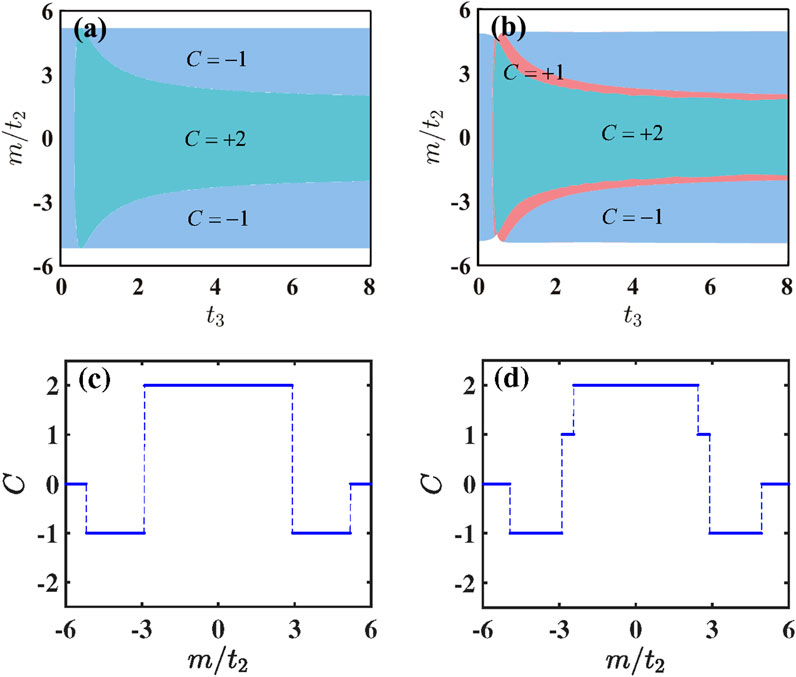
Figure 4. Phase diagrams of the two valence bands are depicted on the
3.3 Topological edge states in semi-infinite honeycomb lattice
According to the bulk-boundary correspondence, edge states are expected to emerge in systems characterized by a non-zero Chern number. Previous studies, including those involving the Haldane model [20], have corroborated this behavior by demonstrating that the number of edge states corresponds to the associated Chern number. To clarify the bulk-edge correspondence and determine whether the edge states in the current system exhibit topological or trivial properties, we will analyze the characteristics of edge states in a semi-infinite honeycomb lattice ribbon geometry [16, 60–62]. This geometry is infinite in the
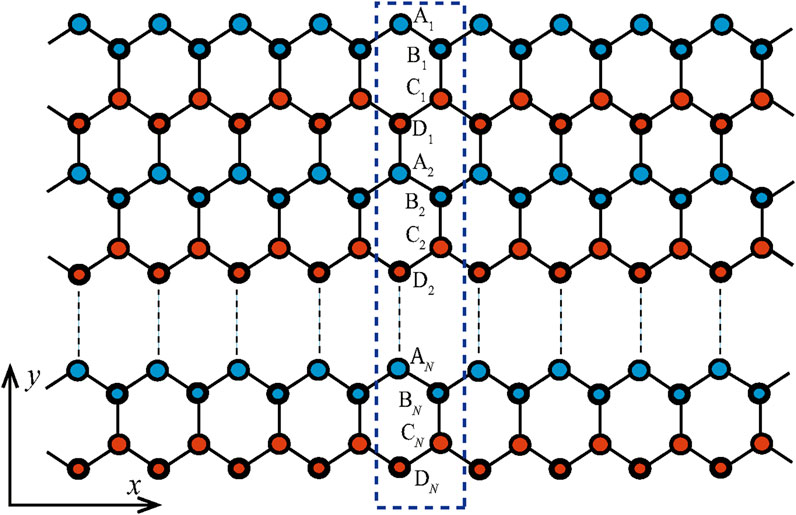
Figure 5. Schematic of a semi-infinite ribbon with zigzag edges to be finite along the
where
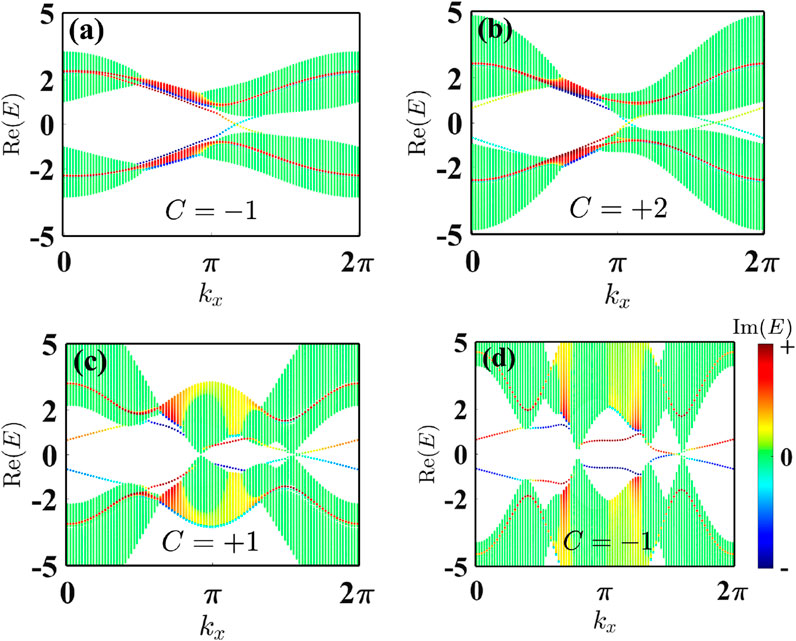
Figure 6. Energy spectra of a semi-infinite ribbon as a function of dimensionless momentum
4 Conclusion
We have constructed a non-Hermitian modified Haldane model and analyzed its symmetries, demonstrating that the system satisfies both the pseudo-Hermitian and anti-
Data availability statement
The original contributions presented in the study are included in the article/supplementary material, further inquiries can be directed to the corresponding author.
Author contributions
X-CC: Conceptualization, Data curation, Formal Analysis, Investigation, Methodology, Software, Validation, Visualization, Writing – original draft, Writing – review and editing. X-FN: Formal Analysis, Software, Writing – original draft. Y-W-YL: Formal Analysis, Software, Writing – original draft. W-XC: Conceptualization, Data curation, Formal Analysis, Funding acquisition, Investigation, Methodology, Project administration, Resources, Software, Supervision, Validation, Visualization, Writing – original draft, Writing – review and editing.
Funding
The author(s) declare that financial support was received for the research and/or publication of this article. This work was supported by National Natural Science Foundation of China (Grant No. 62301472) and Jilin Provincial Natural Science Foundation of China (Grant No. YDZJ202201ZYTS298).
Conflict of interest
The authors declare that the research was conducted in the absence of any commercial or financial relationships that could be construed as a potential conflict of interest.
Generative AI statement
The author(s) declare that no Generative AI was used in the creation of this manuscript.
Publisher’s note
All claims expressed in this article are solely those of the authors and do not necessarily represent those of their affiliated organizations, or those of the publisher, the editors and the reviewers. Any product that may be evaluated in this article, or claim that may be made by its manufacturer, is not guaranteed or endorsed by the publisher.
References
1. von Klitzing K. The quantized Hall effect. Rev Mod Phys (1986) 58:519–31. doi:10.1103/RevModPhys.58.519
2. Hasan MZ, Kane CL. Colloquium: topological insulators. Rev Mod Phys (2010) 82:3045–67. doi:10.1103/RevModPhys.82.3045
3. Qi XL, Zhang SC. Topological insulators and superconductors. Rev Mod Phys (2011) 83:1057–110. doi:10.1103/RevModPhys.83.1057
4. Zhang Y, Kartashov YV, Ferrando A. Interface states in polariton topological insulators. Phys Rev A (2019) 99:053836. doi:10.1103/PhysRevA.99.053836
5. Dey B, Kapri P, Pal O, Ghosh TK. Unconventional phases in a Haldane model of dice lattice. Phys Rev B (2020) 101:235406. doi:10.1103/PhysRevB.101.235406
6. Denner MM, Skurativska A, Schindler F, Fischer MH, Thomale R, Bzdušek T, et al. Exceptional topological insulators. Nat Commun (2021) 12:5681. doi:10.1038/s41467-021-25947-z
7. Mai P, Feldman BE, Phillips PW. Topological Mott insulator at quarter filling in the interacting Haldane model. Phys Rev Res (2023) 5:013162. doi:10.1103/PhysRevResearch.5.013162
8. Alase A, Feder DL. Generating and detecting topological phases with higher Chern number. Phys Rev A (2021) 103:053305. doi:10.1103/PhysRevA.103.053305
9. Łącki M, Zakrzewski J, Goldman N. A dark state of Chern bands: designing flat bands with higher Chern number. SciPost Phys (2021) 10:112. doi:10.21468/SciPostPhys.10.5.112
10. Wang B, Zhou X, Lin H, Bansil A. Higher-order topological insulator phase in a modified Haldane model. Phys Rev B (2021) 104:L121108. doi:10.1103/PhysRevB.104.L121108
11. Chang ZW, Hao WC, Liu X. Topological defects in Haldane model and higher Chern numbers in monolayer graphene. J Phys Condens Matter (2022) 34:485502. doi:10.1088/1361-648X/ac98fc
12. Mondal S, Basu S. Topological phases of a semi-Dirac Chern insulator in the presence of extended range hopping. Phys Rev B (2022) 105:235441. doi:10.1103/PhysRevB.105.235441
13. Li Q, Wu YJ, Yu J, He J. Phase driven topological states in correlated Haldane model on a honeycomb lattice. J Phys Condens Matter (2022) 34:275602. doi:10.1088/1361-648X/ac6851
14. Geng WJ, Wang YJ, Zhang ZX, Cao J, Cui WX, Wang HF. Separable zero energy topological edge states and nonzero energy gap states in the nonreciprocal Su-Schrieffer-Heeger model. Phys Rev B (2023) 108:144109. doi:10.1103/PhysRevB.108.144109
15. Jia W, Zhou XC, Zhang L, Zhang L, Liu XJ. Unified characterization for higher-order topological phase transitions. Phys Rev Res (2023) 5:L022032. doi:10.1103/PhysRevResearch.5.L022032
16. He WX, Mondaini R, Luo HG, Wang X, Hu S. Phase transitions in the Haldane-Hubbard model. Phys Rev B (2024) 109:035126. doi:10.1103/PhysRevB.109.035126
17. Yang F, Ling YX, Yan XH, Qi L, Zhang X, Han Y, et al. Porous Haldane model: topological phase transitions and flat bands. J Phys Condens Matter (2024) 37:075501. doi:10.1088/1361-648X/ad9723
18. Guan JH, Lou WK, Chang K. Topological hidden phase transition in honeycomb bilayers with a high Chern number. Phys Rev B (2024) 110:165303. doi:10.1103/PhysRevB.110.165303
19. Cheng S, Jiang Y, Xianlong G. Bulk-edge correspondence for the nonlinear eigenvalues problem of the Haldane model. Phys Rev B (2024) 109:134201. doi:10.1103/PhysRevB.109.134201
20. Haldane FDM. Model for a Quantum Hall Effect without Landau Levels: condensed-matter realization of the “parity anomaly”. Phys Rev Lett (1988) 61:2015–8. doi:10.1103/PhysRevLett.61.2015
21. Chang CZ, Zhang J, Feng X, Shen J, Zhang Z, Guo M, et al. Experimental observation of the Quantum Anomalous Hall Effect in a magnetic topological insulator. Science (2013) 340:167–70. doi:10.1126/science.1234414
22. Gong Z, Ashida Y, Kawabata K, Takasan K, Higashikawa S, Ueda M. Topological phases of non-Hermitian systems. Phys Rev X (2018) 8:031079. doi:10.1103/PhysRevX.8.031079
23. Xue H, Wang Q, Zhang B, Chong YD. Non-Hermitian Dirac Cones. Phys Rev Lett (2020) 124:236403. doi:10.1103/PhysRevLett.124.236403
24. Teo HT, Xue H, Zhang B. Topological phase transition induced by gain and loss in a photonic Chern insulator. Phys Rev A (2022) 105:053510. doi:10.1103/PhysRevA.105.053510
25. Li Y, Liang C, Wang C, Lu C, Liu YC. Gain-loss-induced hybrid skin-topological effect. Phys Rev Lett (2022) 128:223903. doi:10.1103/PhysRevLett.128.223903
26. Sun J, Li CA, Feng S, Guo H. Hybrid higher-order skin-topological effect in hyperbolic lattices. Phys Rev B (2023) 108:075122. doi:10.1103/PhysRevB.108.075122
27. Eleuch H, Rotter I. Open quantum systems with loss and gain. Int J Theor Phys (2015) 54:3877–88. doi:10.1007/s10773-014-2375-3
28. Ashida Y, Gong Z, Ueda M. Non-Hermitian physics. Adv Phys (2020) 69:249–435. doi:10.1080/00018732.2021.1876991
29. Leykam D, Bliokh KY, Huang C, Chong YD, Nori F. Edge modes, degeneracies, and topological numbers in non-Hermitian systems. Phys Rev Lett (2017) 118:040401. doi:10.1103/PhysRevLett.118.040401
30. Kawabata K, Shiozaki K, Ueda M, Sato M. Symmetry and topology in non-Hermitian physics. Phys Rev X (2019) 9:041015. doi:10.1103/PhysRevX.9.041015
31. Fan A, Liang SD. Complex energy plane and topological invariant in non-Hermitian systems. Front Phys (2022) 17:33501. doi:10.1007/s11467-021-1122-5
32. Brody DC. Biorthogonal quantum mechanics. J Phys A: Math Theor (2013) 47:035305. doi:10.1088/1751-8113/47/3/035305
33. Bender CM, Boettcher S. Real spectra in non-Hermitian Hamiltonians having PT symmetry. Phys Rev Lett (1998) 80:5243–6. doi:10.1103/PhysRevLett.80.5243
34. Bender CM, Brody DC, Jones HF. Complex extension of quantum mechanics. Phys Rev Lett (2002) 89:270401. doi:10.1103/PhysRevLett.89.270401
35. Guo A, Salamo GJ, Duchesne D, Morandotti R, Volatier-Ravat M, Aimez V, et al. Observation of PT-symmetry breaking in complex optical potentials. Phys Rev Lett (2009) 103:093902. doi:10.1103/PhysRevLett.103.093902
36. Song F, Yao S, Wang Z. Non-Hermitian skin effect and chiral damping in open quantum systems. Phys Rev Lett (2019) 123:170401. doi:10.1103/PhysRevLett.123.170401
37. Okugawa R, Takahashi R, Yokomizo K. Second-order topological non-Hermitian skin effects. Phys Rev B (2020) 102:241202. doi:10.1103/PhysRevB.102.241202
38. Yi Y, Yang Z. Non-Hermitian skin modes induced by on-site dissipations and chiral tunneling effect. Phys Rev Lett (2020) 125:186802. doi:10.1103/PhysRevLett.125.186802
39. Chen WC, Liu R, Wang YF, Gong CD. Topological quantum phase transitions and topological flat bands on the star lattice. Phys Rev B (2012) 86:085311. doi:10.1103/PhysRevB.86.085311
40. Yang S, Gu ZC, Sun K, Das Sarma S. Topological flat band models with arbitrary Chern numbers. Phys Rev B (2012) 86:241112. doi:10.1103/PhysRevB.86.241112
41. Harari G, Bandres MA, Lumer Y, Rechtsman MC, Chong YD, Khajavikhan M, et al. Topological insulator laser: theory. Science (2018) 359:eaar4003. doi:10.1126/science.aar4003
42. Luo XW, Zhang C. Higher-Order topological corner states induced by gain and loss. Phys Rev Lett (2019) 123:073601. doi:10.1103/PhysRevLett.123.073601
43. Ozawa T, Price HM, Amo A, Goldman N, Hafezi M, Lu L, et al. Topological photonics. Rev Mod Phys (2019) 91:015006. doi:10.1103/RevModPhys.91.015006
44. Kremer M, Biesenthal T, Maczewsky LJ, Heinrich M, Thomale R, Szameit A. Demonstration of a two-dimensional
45. Song AY, Sun XQ, Dutt A, Minkov M, Wojcik C, Wang H, et al. PT-symmetric topological edge-gain effect. Phys Rev Lett (2020) 125:033603. doi:10.1103/PhysRevLett.125.033603
46. Yan Q, Zhao B, Zhou R, Ma R, Lyu Q, Chu S, et al. Advances and applications on non-Hermitian topological photonics. Nanophotonics (2023) 12:2247–71. doi:10.1515/nanoph-2022-0775
47. Zhang DW, Zhu YQ, Zhao Y, Yan H, Zhu SL. Topological quantum matter with cold atoms. Adv Phys (2018) 67:253–402. doi:10.1080/00018732.2019.1594094
48. Li L, Lee CH, Gong J. Topological switch for non-Hermitian skin effect in cold-atom systems with loss. Phys Rev Lett (2020) 124:250402. doi:10.1103/PhysRevLett.124.250402
49. Xu ZC, Zhou Z, Cheng E, Lang LJ, Zhu SL. Gain/loss effects on spin-orbit coupled ultracold atoms in two-dimensional optical lattices. Sci China Phys Mech Astron (2022) 65:283011. doi:10.1007/s11433-022-1898-7
50. Luo K, Feng J, Zhao YX, Yu R. Nodal manifolds bounded by exceptional points on non-Hermitian honeycomb lattices and electrical-circuit realizations arXiv: mesoscale and nanoscale physics (2018) arXiv:1810.09231. doi:10.48550/arXiv.1810.09231
51. Ezawa M. Electric circuits for non-Hermitian Chern insulators. Phys Rev B (2019) 100:081401. doi:10.1103/PhysRevB.100.081401
52. Wu J, Huang X, Yang Y, Deng W, Lu J, Deng W, et al. Non-Hermitian second-order topology induced by resistances in electric circuits. Phys Rev B (2022) 105:195127. doi:10.1103/PhysRevB.105.195127
53. Zhang X, Wu C, Yan M, Liu N, Wang Z, Chen G. Observation of continuum Landau modes in non-Hermitian electric circuits. Nat Commun (2024) 15:1798. doi:10.1038/s41467-024-46122-0
54. Mostafazadeh A. Pseudo-Hermitian representation of quantum mechanics. Int J Geom Meth Mod Phys (2010) 7:1191–306. doi:10.1142/S0219887810004816
55. He P, Zhu YQ, Wang JT, Zhu SL. Quantum quenches in a pseudo-Hermitian Chern insulator. Phys Rev A (2023) 107:012219. doi:10.1103/PhysRevA.107.012219
56. Starkov GA, Fistul MV, Eremin IM. Formation of exceptional points in pseudo-Hermitian systems. Phys Rev A (2023) 108:022206. doi:10.1103/PhysRevA.108.022206
57. El-Ganainy R, Makris KG, Khajavikhan M, Musslimani ZH, Rotter S, Christodoulides DN. Non-Hermitian physics and PT symmetry. Nat Phys (2018) 14:11–9. doi:10.1038/nphys4323
58. Ni X, Smirnova D, Poddubny A, Leykam D, Chong Y, Khanikaev AB. PT phase transitions of edge states at PT symmetric interfaces in non-Hermitian topological insulators. Phys Rev B (2018) 98:165129. doi:10.1103/PhysRevB.98.165129
59. Cen J, Saxena A. Anti-PT symmetric qubit: decoherence and entanglement entropy. Phys Rev A (2022) 105:022404. doi:10.1103/PhysRevA.105.022404
60. Ablowitz MJ, Curtis CW, Ma YP. Linear and nonlinear traveling edge waves in optical honeycomb lattices. Phys Rev A (2014) 90:023813. doi:10.1103/PhysRevA.90.023813
61. Ling HY, Kain B. Topological study of a Bogoliubov–de Gennes system of pseudo-spin-1/2 bosons with conserved magnetization in a honeycomb lattice. Phys Rev A (2022) 105:023319. doi:10.1103/PhysRevA.105.023319
Keywords: modified Haldane model, pseudo-Hermitian and anti-PT symmetries, topological phase transitions, long-rang hoppings, gain-loss effects
Citation: Chen X-C, Nie X-F, Li Y-W-Y and Cui W-X (2025) Symmetries and topological phase transitions in modified Haldane models with long-range hoppings and gain-loss effects. Front. Phys. 13:1572883. doi: 10.3389/fphy.2025.1572883
Received: 07 February 2025; Accepted: 31 March 2025;
Published: 16 April 2025.
Edited by:
Jamal Berakdar, Martin Luther University of Halle-Wittenberg, GermanyReviewed by:
Outmane Oubram, Universidad Autónoma del Estado de Morelos, MexicoMichael Schüler, Paul Scherrer Institut (PSI), Switzerland
Copyright © 2025 Chen, Nie, Li and Cui. This is an open-access article distributed under the terms of the Creative Commons Attribution License (CC BY). The use, distribution or reproduction in other forums is permitted, provided the original author(s) and the copyright owner(s) are credited and that the original publication in this journal is cited, in accordance with accepted academic practice. No use, distribution or reproduction is permitted which does not comply with these terms.
*Correspondence: Wen-Xue Cui, Y3Vpd2VueHVlQHlidS5lZHUuY24=
 Xiao-Cui Chen
Xiao-Cui Chen Xiao-Feng Nie
Xiao-Feng Nie Ye-Wei-Yi Li
Ye-Wei-Yi Li Wen-Xue Cui
Wen-Xue Cui